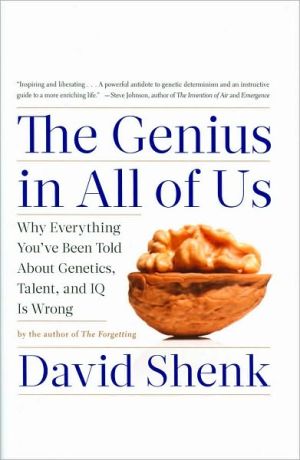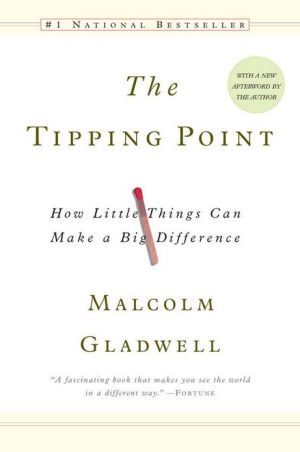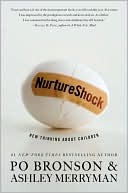The Genius in All of Us: Why Everything You've Been Told About Genetics, Talent, and IQ Is Wrong
With irresistibly persuasive vigor, David Shenk debunks the long-standing notion of genetic “giftedness,” and presents dazzling new scientific research showing how greatness is in the reach of every individual.\ \ DNA does not make us who we are. “Forget everything you think you know about genes, talent, and intelligence,” he writes. “In recent years, a mountain of scientific evidence has emerged suggesting a completely new paradigm: not talent scarcity, but latent talent abundance.”\...
Search in google:
With irresistibly persuasive vigor, David Shenk debunks the long-standing notion of genetic “giftedness,” and presents dazzling new scientific research showing how greatness is in the reach of every individual. DNA does not make us who we are. “Forget everything you think you know about genes, talent, and intelligence,” he writes. “In recent years, a mountain of scientific evidence has emerged suggesting a completely new paradigm: not talent scarcity, but latent talent abundance.” Integrating cutting-edge research from a wide swath of disciplines—cognitive science, genetics, biology, child development—Shenk offers a highly optimistic new view of human potential. The problem isn't our inadequate genetic assets, but our inability, so far, to tap into what we already have. IQ testing and widespread acceptance of “innate” abilities have created an unnecessarily pessimistic view of humanity—and fostered much misdirected public policy, especially in education. The truth is much more exciting. Genes are not a “blueprint” that bless some with greatness and doom most of us to mediocrity or worse. Rather our individual destinies are a product of the complex interplay between genes and outside stimuli-a dynamic that we, as people and as parents, can influence. This is a revolutionary and optimistic message. We are not prisoners of our DNA. We all have the potential for greatness. The New York Times - Annie Murphy Paul It's ambitious indeed to try to overthrow in one go the conventional ideas and images that have accumulated since 1874, when Francis Galton first set the words "nature" and "nurture' against each other. Yet Shenk convinces the reader that such a coup is necessary, and he gets it well under way. He tells engaging stories, lucidly explains complex research and offers fresh insights into the nature of exceptional performance…Just how tall a task Shenk took on is evident in his voluminous endnotes, which go on as long as the main text and are just as interesting. Here the author allows us to watch him working his way through the literature, inquiring, arguing, marveling, as he wrestles a new understanding into being…a deeply interesting and important book.
The Genius in All of Us\ Why Everything You've Been Told About Genetics, Talent, and IQ Is Wrong \ \ By David Shenk \ Doubleday\ Copyright © 2010 David Shenk\ All right reserved.\ ISBN: 9780385523653 \ \ \ chapter one\ \ Genes 2.0\ \ How Genes Really Work\ \ Contrary to what we’ve been taught, genes do not determine physical and character traits on their own. Rather, they interact with the environment in a dynamic, ongoing process that produces and continually refines an individual.\ \ The sun begins to rise over an old river town, and through a fifth- floor window of University Hospital, a newborn cries out her own birth announcement. Her new, already sleep-deprived parents hold her tightly and simply stare, partly in disbelief that this has actually happened, partly in awe of what lies ahead. As she develops, who will she look like? What will she be like? What will be her strengths, her weaknesses? Will she change the world or just scrape by? Will she run a quick mile, paint a new idea, charm her friends, sing for millions? Will she have any talent for anything?\ \ Only the years will tell. For right now, the parents don’t really need to know the final outcome—they just need to know what sort of difference they can make. How much of their newborn daughter’s personality and abilities are already predetermined? What portion is still up for grabs? What ingredients can they add, and what tactics should they avoid?\ \ The fuzzy mix of hope, expectation, and burden begins . . .\ \ TONY SOPRANO: And to think [I’m] the cause of it.\ \ DR. MELFI: How are you the cause of it?\ \ TONY SOPRANO: It’s in his blood, this miserable fucking existence. My rotten fucking putrid genes have infected my kid’s soul. That’s my gift to my son.\ \ Genes can be scary stuff if you don’t understand them. In 1994, psychologist Richard Herrnstein and policy analyst Charles Murray warned in their bestselling book The Bell Curve that we live in an increasingly stratified world where the “cognitive elite”—those with the best genes—are more and more isolated from the cognitive/genetic underclass. “Genetic partitioning,” they called it. There was no mistaking their message:\ \ The irony is that as America equalizes the [environmental] circumstances of people’s lives, the remaining differences in intelligence are increasingly determined by differences in genes . . . Putting it all together, success and failure in the American economy, and all that goes with it, are increasingly a matter of the genes that people inherit.\ \ Stark and terrifying—and thankfully quite mistaken. The authors had fundamentally misinterpreted a number of studies, becoming convinced that roughly 60 percent of each person’s intelligence comes directly from his or her genes. But genes don’t work that way. “There are no genetic factors that can be studied independently of the environment,” explains McGill University’s Michael Meaney. “And there are no environmental factors that function independently of the genome. [A trait] emerges only from the interaction of gene and environment.”\ \ While Herrnstein and Murray adhered to a particular ideological agenda, they also seem to have been genuinely hobbled in their analysis by a common misunderstanding of how genes work. We’ve all been taught that we inherit complex traits like intelligence straight from our parents’ DNA in the same way we inherit simple traits like eye color. This belief is continually reinforced by the popular media. As an illustration, USA Today recently explained heredity in this way:\ \ Think of your own genetic makeup as the hand of cards you were dealt at conception. With each conception in a family comes a new shuffling of the deck and a new hand. That’s partly why little Bobby sleeps through the night as a baby, always behaves and seems to love math, while brother Billy is colicky, never listens and already is the head of a gang in kindergarten.\ \ Genes dictate. Genes instruct. Genes determine. For more than a century, this has been the widely accepted explanation of how each of us becomes us. In his famous pea-plant experiments of the 1850s and ’60s, Gregor Mendel demonstrated that basic traits like seed shape and flower color were reliably passed from one generation to the next through dominant and recessive “heritable factors” (Mendel’s phrase before the word “gene” was introduced). After eight years and twenty- eight thousand plants, Mendel had proved the existence of genes—and seemed to prove that genes alone determined the essence of who we are. Such was the unequivocal interpretation of early-twentieth- century geneticists.\ \ That notion is with us still. “Genes set the stage,” affirms USA Today. The environment has an impact on all of our lives, to be sure, but genes come first; they set specific lower and upper limits of each person’s potential abilities. Where did your brother get that amazing singing voice? How did you get so tall? Why can’t I dance? How is she so quick with numbers?\ \ “It’s in the genes,” we say.\ \ That’s what The Bell Curve authors thought, too. None of these writers realized that over the last two decades Mendel’s ideas have been thoroughly upgraded—so much so that one large group of scientists now suggests that we need to wipe the slate clean and construct an entirely new understanding of genes.\ \ This new vanguard is a loose-knit group of geneticists, neuroscientists, cognitive psychologists, and others, some of whom call themselves developmental systems theorists. I call them interactionists because of their emphasis on the dynamic interaction between genes and the environment. Not all of the interactionists’ views have yet been fully accepted, and they freely acknowledge their ongoing struggle to articulate the full implications of their findings. But it already seems very clear that these implications are far-reaching and paradigm-shifting.\ \ To understand interactionism, you must first try to forget everything you think you know about heredity. “The popular conception of the gene as a simple causal agent is not valid,” declare geneticists Eva Jablonka and Marion Lamb. “The gene cannot be seen as an autonomous unit—as a particular stretch of DNA which always produces the same effect. Whether or not a length of DNA produces anything, what it produces, and where and when it produces it may depend on other DNA sequences and on the environment.”\ \ Though Mendel couldn’t detect it with his perfectly calibrated pea- plant hybrids, genes are not like robot actors who always say the same lines in the exact same way. It turns out that they interact with their surroundings and can say different things depending on whom they are talking to.\ \ This obliterates the long-standing metaphor of genes as blueprints with elaborate predesigned instructions for eye color, thumb size, mathematical quickness, musical sensitivity, etc. Now we can come up with a more accurate metaphor. Rather than finished blueprints, genes— all twenty-two thousand of them1—are more like volume knobs and switches. Think of a giant control board inside every cell of your body.\ \ Many of those knobs and switches can be turned up/down/on/off at any time—by another gene or by any minuscule environmental input. This flipping and turning takes place constantly. It begins the moment a child is conceived and doesn’t stop until she takes her last breath. Rather than giving us hardwired instructions on how a trait must be expressed, this process of gene-environment interaction drives a unique developmental path for every unique individual.\ \ The new interactionists call it “GxE” for short. It has become central to the understanding of all genetics. Recognition of GxE means that we now realize that genes powerfully influence the formation of all traits, from eye color to intelligence, but rarely dictate precisely what those traits will be. From the moment of conception, genes constantly respond to, and interact with, a wide range of internal and external stimuli—nutrition, hormones, sensory input, physical and intellectual activity, and other genes—to produce a unique, custom-tailored human machine for each person’s unique circumstance. Genes matter, and genetic differences will result in trait differences, but in the final analysis, each of us is a dynamic system, a creature of development.\ \ This new dynamic model of GxE (genes multiplied by environment) is very different from the old static model of G+E (genes plus environment). Under the old paradigm, genes came first and set the stage. They dealt each of us our first hand of cards, and only afterward could we add in environmental influences.\ \ The new model begins with interaction. There is no genetic foundation that gets laid before the environment enters in; rather, genes express themselves strictly in accordance with their environment. Everything that we are, from the first moment of conception, is a result of this process. We do not inherit traits directly from our genes. Instead, we develop traits through the dynamic process of gene- environment interaction. In the GxE world, genetic differences still matter enormously. But, on their own, they don’t determine who we are.\ \ In fact, you did not even inherit your blue eyes or brown hair from your parents’ genes. Not directly.\ \ This may sound crazy at first, because of how thoroughly we’ve been indoctrinated with Mendelian genetics. The reality turns out to be much more complicated—even for pea plants. Many scientists have understood this much more complicated truth for years but have had trouble explaining it to the general public. It is indeed a lot harder to explain than simple genetic determinism.\ \ To understand genes more fully, we first need to take a step back and explain what they actually do:\ \ Genes direct the production of proteins.\ \ Each of our cells contains a complete double strand of DNA, which in turn contains thousands of individual genes. Each gene initiates the process of assembling amino acids into proteins. Proteins are large, specialized molecules that help create cells, transport vital elements, and produce necessary chemical reactions. There are many different protein types, and they provide the building blocks of everything from muscle fiber to eyeball collagen to hemoglobin. We are, each one of us, the sum of our proteins.\ \ Genes contain the instructions for the formation of those proteins, and they direct the protein-building process.\ \ But . . . genes are not the only things influencing protein construction. It turns out that the genetic instructions themselves are influenced by other inputs. Genes are constantly activated and deactivated by environmental stimuli, nutrition, hormones, nerve impulses, and other genes.\ \ This explains how every brain cell and hair cell and heart cell in your body can contain all of your DNA but still perform very specialized functions. It also explains how a tiny bit of genetic diversity goes a very long way: human beings are distinct from one another not just because of our relatively few genetic differences, but also because every moment of our ongoing lives actively influences our own genetic expression.\ \ Think of GxE as baking a cake, suggests Cambridge University biologist Patrick Bateson. A hundred cooks may start out with nearly the same ingredients but will in the end produce very different cakes. While the slight difference in ingredients guarantees that differences will exist, it doesn’t dictate what those differences will be. The actual end-result differences arise out of the process. “Development is chemistry,” says Bateson, “and the end product cannot simply be reduced to its ingredients.”\ \ Similarly, the mere presence of a certain gene does not automatically produce a specific type or number of proteins. First, every gene has to be activated—switched on, or “expressed”—in order to initiate protein construction.\ \ Further, geneticists have recently discovered that some genes—we don’t yet know how many—are versatile. In some cases, the exact same gene can produce different proteins depending on how and when it is activated.\ \ All of this means that, on their own, most genes cannot be counted on to directly produce specific traits. They are active participants in the developmental process and are built for flexibility. Anyone seeking to describe them as passive instruction manuals is actually minimizing the beauty and power of the genetic design.\ \ So why do I have brown eyes like my mom and red hair like my dad?\ \ In practical terms, there are many elementary physical traits like eye, hair, and skin color where the process is near Mendelian—where certain genes produce predictable outcomes most of the time. But looks can be deceiving; a simple Mendel-like result doesn’t mean that there wasn’t gene-environment interaction. “Even in the case of eye color,” says Patrick Bateson, “the notion that the relevant gene is the [only] cause is misconceived, because [of] all the other genetic and environmental ingredients.” Indeed, Victor McKusick, the Johns Hopkins geneticist widely regarded as the father of clinical medical genetics, reminds us that in some instances “two blue-eyed parents can produce children with brown eyes.” Recessive genes cannot explain such an event; gene-environment interaction can.\ \ When it comes to more complex traits like physical coordination, personality, and verbal intelligence, gene-environment interaction inevitably moves the process even further away from simple Mendelian patterns.\ \ What about single genetic mutations that predictably cause diseases such as Huntington’s disease?\ \ Single-gene diseases do exist and account for roughly 5 percent of the total disease burden in developed countries. But it’s important not to let such diseases give the wrong impression about how healthy genes work. “A disconnected wire can cause a car to break down,” explains Patrick Bateson. “But this does not mean that the wire by itself is responsible for making the car move.” Similarly, a genetic defect causing a series of problems does not mean that the healthy version of that gene is single-handedly responsible for normal function.\ \ Helping the public understand gene-environment interaction is a particular burden, because it is so enormously complex. It will never have the same easy, snap-your-fingers resonance that our old (misleading) understanding of genes had for us. Given that, the interactionists are lucky to have Patrick Bateson on their side. A former biological secretary to the Royal Society of London and one of the world’s leading public educators about heredity, Bateson also carries a powerful symbolic message with his surname. It was his grandfather’s famous cousin, William Bateson, who, a century ago, first coined the word “genetics” and helped popularize the earlier, simpler notion of genes as self-contained information packets that directly produce traits. Now the third-generation Bateson is helping to significantly update that public understanding. \ \ Continues... \ \ \ \ Excerpted from The Genius in All of Us by David Shenk Copyright © 2010 by David Shenk. Excerpted by permission.\ All rights reserved. No part of this excerpt may be reproduced or reprinted without permission in writing from the publisher.\ Excerpts are provided by Dial-A-Book Inc. solely for the personal use of visitors to this web site. \ \
THE ARGUMENTIntroduction: The Kid Part One: The Myth of Gifts CHAPTER ONEGenes 2.0—How Genes Really Work Contrary to what we’ve been taught, genes do not determine physical and character traits on their own. Rather, they interact with the environment in a dynamic, ongoing process that produces and continually refines an individual. CHAPTER TWOIntelligence Is a Process, Not a Thing Intelligence is not an innate aptitude, hardwired at conception or in the womb, but a collection of developing skills driven by the interaction between genes and environment. No one is born with a predetermined amount of intelligence. Intelligence (and IQ scores) can be improved. Few adults come close to their true intellectual potential. CHAPTER THREEThe End of “Giftedness” (and the True Source of Talent) Like intelligence, talents are not innate gifts, but the result of a slow, invisible accretion of skills developed from the moment of conception. Everyone is born with differences, and some with unique advantages for certain tasks. But no one is genetically designed into greatness and few are biologically restricted from attaining it. CHAPTER FOURThe Similarities and Dissimilarities of Twins Identical twins often do have striking similarities, but for reasons far beyond their genetic profiles. They can also have surprising (and often overlooked) differences. Twins are fascinating products of the interaction between genes and environment; this has been missed as “heritability” studies have been wildly misinterpreted. In reality, twin studies do not reveal any percentage of direct genetic influence and tell us absolutely nothing about individual potential. CHAPTER FIVEProdigies and Late Bloomers Child prodigies and superlative adult achievers are often not the same people. Understanding what makes remarkable abilities appear at different phases of a person’s life provides an important insight into what talent really is. CHAPTER SIXCan White Men Jump? Ethnicity, Genes, Culture, and Success Clusters of ethnic and geographical athletic success prompt suspicions of hidden genetic advantages. The real advantages are far more nuanced—and less hidden. Part Two: Cultivating Greatness CHAPTER SEVENHow to Be a Genius (or Merely Great) The old nature/nurture paradigm suggests that control over our lives is divided between genes (nature) and our own decisions (nurture). In fact, we have far more control over our genes—and far less control over our environment—than we think. CHAPTER EIGHTHow to Ruin (or Inspire) a Kid Parenting does matter. There is much parents can do to encourage their kids to become achievers, and there are some important mistakes to avoid. CHAPTER NINEHow to Foster a Culture of Excellence It must not be left to genes and parents to foster greatness; spurring individual achievement is also the dud of society. Every culture must strive to foster values that bring out the best in its people. CHAPTER TENGenes 2.1—How to Improve Your Genes We have long understood that lifestyle cannot alter heredity. But it turns out that it can . . . Epilogue: Ted Williams Field THE EVIDENCE Sources and Notes, Clarifications and Amplifications Bibliography Acknowledgments








